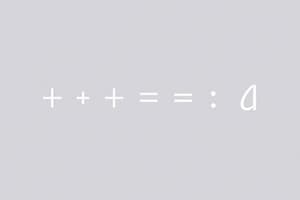Podcast
Questions and Answers
What is primarily blocking the text on the left page of the open book?
What is primarily blocking the text on the left page of the open book?
- A fold in the page
- A bookmark
- A large illustration
- A person's hand (correct)
What language is the text on the right page of the open book mostly written in?
What language is the text on the right page of the open book mostly written in?
- English
- Spanish
- A foreign language (correct)
- Sign language
What can be inferred about the visibility of the text on both pages of the open book?
What can be inferred about the visibility of the text on both pages of the open book?
- Both pages are equally obscured.
- Most of the text on the right page is visible. (correct)
- The left page is completely visible.
- Only the text on the left page is written well.
What detail about the book can be deduced from the description provided?
What detail about the book can be deduced from the description provided?
Which of the following statements about the open book is true?
Which of the following statements about the open book is true?
What do the two sides of the triangle represent in vector addition?
What do the two sides of the triangle represent in vector addition?
Which of the following expressions correctly represents the magnitude of the resultant vector R?
Which of the following expressions correctly represents the magnitude of the resultant vector R?
How is the direction of the resultant vector R determined?
How is the direction of the resultant vector R determined?
In the graphical method of vector addition, which step is performed first?
In the graphical method of vector addition, which step is performed first?
What is the role of angle θ in the calculation of the resultant vector R?
What is the role of angle θ in the calculation of the resultant vector R?
Which of the following is a scalar quantity?
Which of the following is a scalar quantity?
What is a null vector?
What is a null vector?
Which process describes how to represent a vector graphically?
Which process describes how to represent a vector graphically?
What is the property of equal vectors?
What is the property of equal vectors?
Which of the following is true about the cross product of a null vector?
Which of the following is true about the cross product of a null vector?
What distinguishes vector quantities from scalar quantities?
What distinguishes vector quantities from scalar quantities?
What can be said about co-initial vectors?
What can be said about co-initial vectors?
Which of the following quantities is not a vector?
Which of the following quantities is not a vector?
What does the polygon's law of vectors addition state?
What does the polygon's law of vectors addition state?
In triangle OST, what is the relationship represented by $tan β$?
In triangle OST, what is the relationship represented by $tan β$?
How should vectors be arranged when applying the polygon's law of vectors addition?
How should vectors be arranged when applying the polygon's law of vectors addition?
What does the closing side of the polygon represent in the polygon's law of vectors addition?
What does the closing side of the polygon represent in the polygon's law of vectors addition?
When resolving $tan β$, which of the following equations is correct?
When resolving $tan β$, which of the following equations is correct?
What characterizes a null vector?
What characterizes a null vector?
Under what condition are two vectors considered equal?
Under what condition are two vectors considered equal?
What is the angle between two parallel vectors?
What is the angle between two parallel vectors?
What distinguishes anti-parallel vectors from other vectors?
What distinguishes anti-parallel vectors from other vectors?
How are co-initial vectors defined?
How are co-initial vectors defined?
What is true about localized vectors?
What is true about localized vectors?
Which type of vector represents displacement or velocity?
Which type of vector represents displacement or velocity?
What defines a polar vector?
What defines a polar vector?
Which of the following can be considered a negative vector?
Which of the following can be considered a negative vector?
What do co-planar vectors refer to?
What do co-planar vectors refer to?
What does the Parallelogram Law of Vector Addition state regarding two vectors at a point?
What does the Parallelogram Law of Vector Addition state regarding two vectors at a point?
In the graphical method of finding the resultant of vectors A and B, what geometric shape is used?
In the graphical method of finding the resultant of vectors A and B, what geometric shape is used?
What represents vector B in the analytical method described for the Parallelogram Law?
What represents vector B in the analytical method described for the Parallelogram Law?
What is the resultant R when the angle $𝜃 = 0°$?
What is the resultant R when the angle $𝜃 = 0°$?
What value does cos 𝜃 take when $𝜃 = 180°$?
What value does cos 𝜃 take when $𝜃 = 180°$?
When the angle between vectors A and B is $𝜃 = 90°$, what is true about the resultant R?
When the angle between vectors A and B is $𝜃 = 90°$, what is true about the resultant R?
What is the mathematical representation of the resultant when $𝜃 = 90°$?
What is the mathematical representation of the resultant when $𝜃 = 90°$?
In the right angled triangle formed when determining the resultant, what does ST represent?
In the right angled triangle formed when determining the resultant, what does ST represent?
Flashcards are hidden until you start studying
Study Notes
Scalars and Vectors
- Scalar Quantities require only magnitude (e.g., mass, length, energy).
- Vector Quantities require both magnitude and direction (e.g., displacement, velocity, force).
- Electric current is a scalar quantity despite having both magnitude and direction.
Representation of Vectors
- Vectors are represented by a line with an arrowhead indicating direction.
- Example: For a velocity of 40 m/s due east, use a scale like 1 cm = 10 m/s to draw a 4 cm line pointing east.
Key Vector Terms
- Null Vector: Zero magnitude, arbitrary direction, represented as a point, and does not affect other vectors in addition or subtraction.
- Equal Vectors: Have the same magnitude and direction; represented by equal, parallel lines.
- Negative Vector: Same length as the original vector but points in the opposite direction.
- Co-initial Vectors: Share the same initial point.
- Collinear Vectors: Reside on the same line.
Properties of a Null Vector
- Zero magnitude and arbitrary direction.
- Adding or subtracting a null vector from a given vector results in the original vector.
- Dot and cross products involving a null vector yield zero and a null vector, respectively.
Types of Vectors
- Parallel Vectors: Same direction, angle of 0° between them.
- Anti-parallel Vectors: Opposite directions, angle of 180°.
- Co-planar Vectors: Reside in one plane without regard to direction.
- Localized Vectors: Have a fixed initial point (e.g., position vectors).
- Non-localized Vectors: No fixed tail point; includes force, momentum, etc.
Classification of Vectors
- Polar Vectors: Independent of the frame of reference.
- Free Vectors: Include displacement and velocity; further classified into linear, surface, and volume vectors.
Triangle's Law of Vector Addition
- Vectors represented as two sides of a triangle; the resultant is the third side.
- Graphical method involves drawing vectors and completing the triangle to find the resultant.
- Analytical calculations use trigonometric relationships to find the magnitude and direction of the resultant.
Parallelogram Law of Vector Addition
- Combines two vectors at a point to form a parallelogram; the diagonal represents the resultant.
- Applicable through both graphical and analytical methods to find magnitude and direction.
Special Cases in Parallelogram Law
- When angle θ = 0°: R is maximized (R = A + B).
- When angle θ = 180°: R is minimized (R = A - B).
- When angle θ = 90°: Use Pythagorean theorem for R calculation.
Polygon's Law of Vectors Addition
- Extends to multiple vectors acting simultaneously; represented by the sides of an open polygon.
- The resultant is found by closing the polygon in the opposite order of vector operation.
Studying That Suits You
Use AI to generate personalized quizzes and flashcards to suit your learning preferences.




